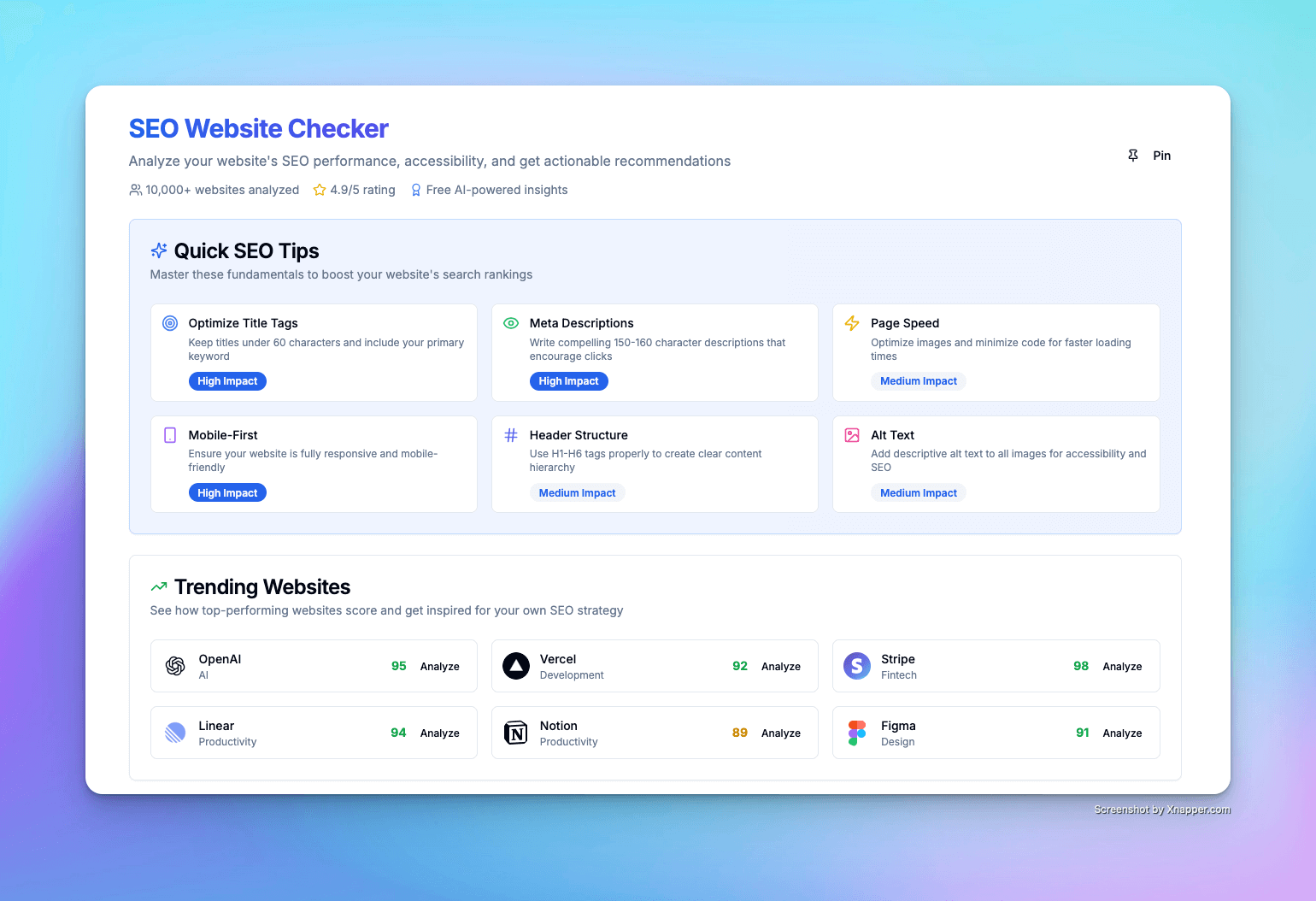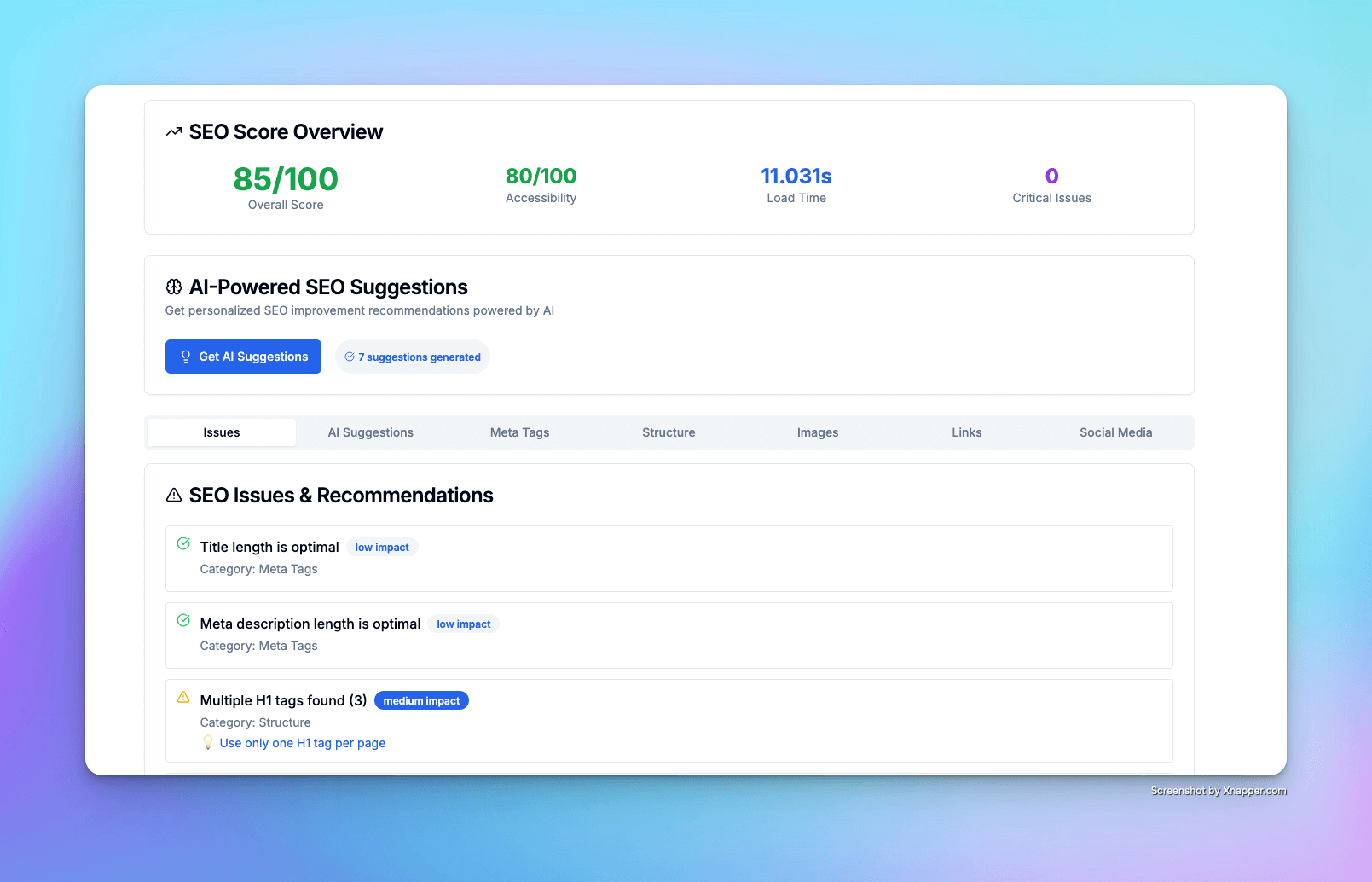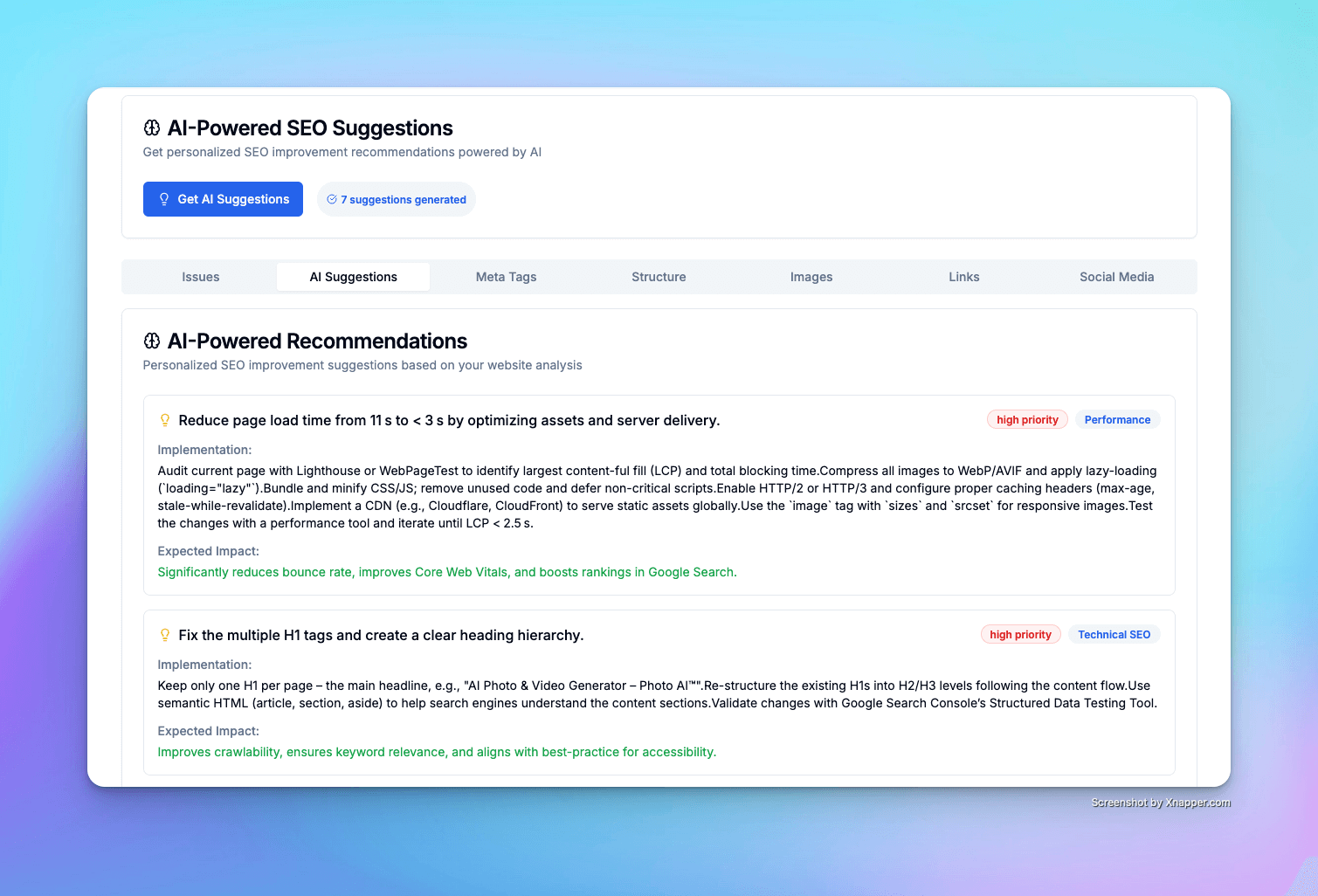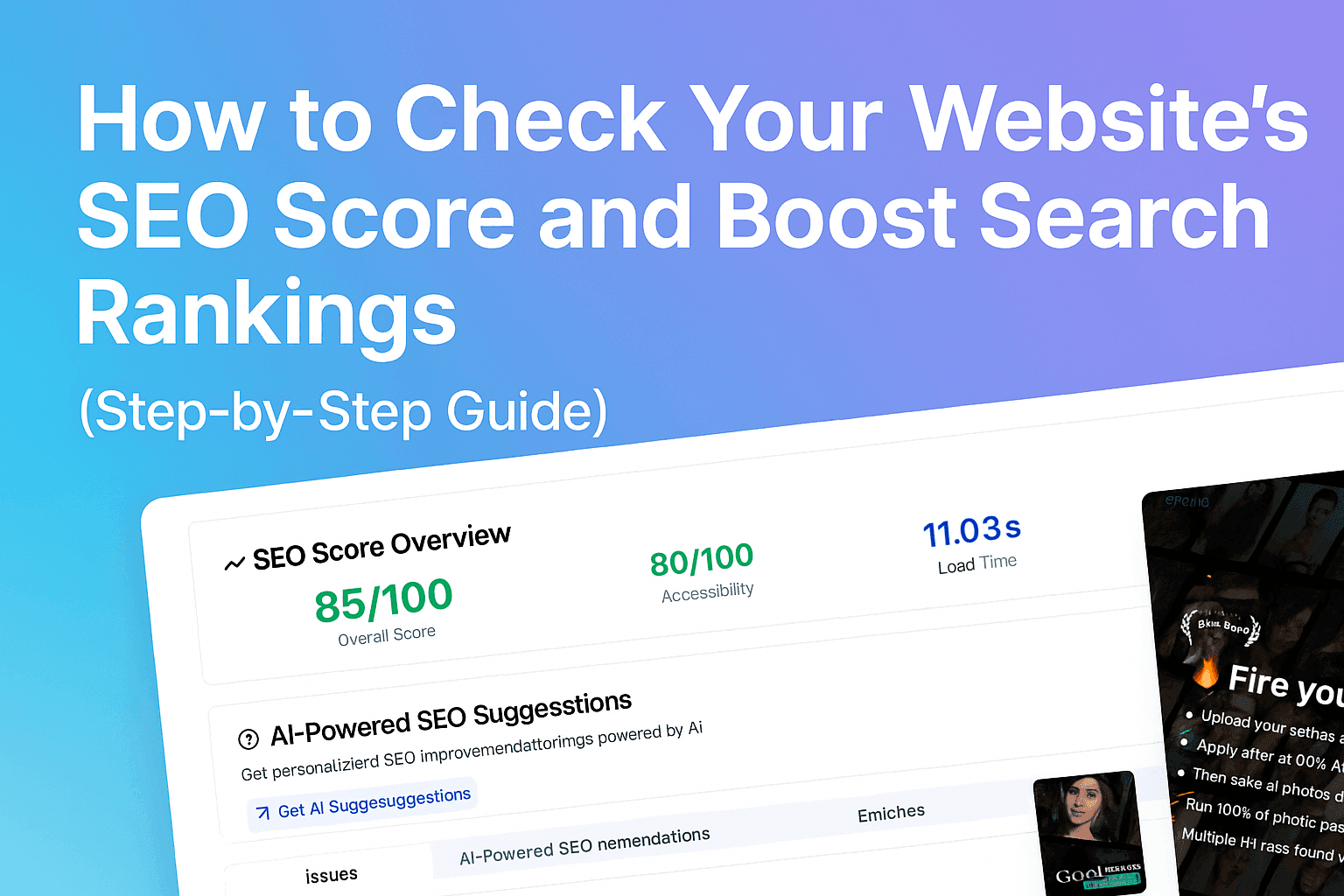In today's digital-first world, your website is often the first interaction potential customers have with your brand. To stand out online and drive consistent traffic, you need to ensure your website is optimized for both search engines and users.
Search Engine Optimization (SEO) is the key to achieving this. A strong SEO strategy helps your site rank higher on Google and emerging AI-powered search platforms, bringing in more organic visitors, leads, and sales.
👉 Quick Start:
You can instantly analyze your website’s SEO performance using Toolover SEO Checker — a free tool that audits your site’s SEO, accessibility, meta tags, heading structure, image optimization, links, and social media metadata. It provides personalized AI-powered recommendations, and you can export the report as JSON or PDF for further use.
This comprehensive, practical guide will show you how to effectively check your website's SEO score and provide actionable steps to improve search rankings, boost visibility, and enhance user experience.
📌 Quick SEO Health Checklist
Before we dive into details, here’s a high-level checklist to keep in mind:
- ✅ Run a technical SEO audit (crawlability, speed, mobile, security).
- ✅ Optimize on-page elements (titles, meta tags, content, internal links).
- ✅ Strengthen your backlink profile and off-page authority.
- ✅ Create high-quality, AI-friendly content with E-E-A-T principles.
- ✅ Prioritize user experience (UX) and Core Web Vitals.
- ✅ Track performance regularly with SEO tools like Toolover SEO Checker.
🚀 Why SEO Matters More Than Ever
SEO has evolved far beyond keywords and backlinks. With AI reshaping how search works, success now depends on understanding user intent, creating high-quality content, and delivering an excellent user experience.
A good SEO score translates into:
- 🌐 Increased Organic Traffic — Higher rankings mean more visibility, clicks, and visitors.
- 🤝 Improved Credibility and Trust — Top-ranking sites are seen as more authoritative.
- ⚡ Better User Experience — Speed, mobile-friendliness, and good UX improve engagement.
- 🥇 Competitive Advantage — Outranking competitors for key terms drives growth.
🧱 Key Pillars of SEO
Before checking your score, understand the core elements that influence rankings:
- Technical SEO – Ensures crawlers can access and index your site properly.
- On-Page SEO – Optimizing page-level elements for search and users.
- Off-Page SEO – Building authority through backlinks and external signals.
- Content SEO – Publishing relevant, valuable content that meets search intent.
- Local SEO – Optimizing your online presence for local searches.
- User Experience (UX) – Delivering fast, mobile-friendly, intuitive navigation.
🧭 Step 1: Run a Technical SEO Audit
Technical issues can seriously hurt your rankings. Start here:
👉 You can run a complete SEO audit in seconds with Toolover SEO Checker.
It analyzes your site’s SEO issues & recommendations, including:
- Meta Tags Analysis
- Heading Structure
- Images Optimization Check
- Links Analysis
- Social Media Meta Tags Review
- Export report as JSON or PDF

🔍 Crawlability & Indexability
- Tools: Google Search Console, Screaming Frog SEO Spider, Toolover SEO Checker
- Check:
robots.txtisn’t blocking important pagessitemap.xmlis current and submitted- Google’s Coverage Report has no critical errors
⚡ Site Speed
- Tools: Google PageSpeed Insights, GTmetrix, WebPageTest
- Check:
- Load times for desktop & mobile
- Optimize images, enable caching, minify CSS/JS
📱 Mobile-Friendliness
- Tool: Google Mobile-Friendly Test
- Check: Responsive design across all devices
🔐 HTTPS & Security
- Check: Ensure your site uses SSL (HTTPS). It’s both a ranking factor and user trust signal.
🧭 Broken Links & Redirects
- Tools: Screaming Frog, Ahrefs Site Audit
- Check: Fix 404 errors and set up proper 301 redirects.
🧠 Structured Data (Schema)
- Tools: Google Rich Results Test, Schema.org
- Check: Add schema markup for better search visibility (e.g., FAQs, products, events).
📝 Step 2: Analyze On-Page SEO
On-page factors improve relevance and user experience.
🔑 Keyword Research
- Tools: Google Keyword Planner, Ahrefs, Semrush, Ubersuggest
- Check: Target keywords with good volume, clear intent, and manageable competition.
🏷️ Title Tags & Meta Descriptions
- Title: ≤ 60 characters | Meta: ≤ 160 characters
- Include target keywords naturally and make them compelling.
🧱 Header Tags (H1, H2, H3…)
- Use one H1 for the main topic.
- Use H2–H6 to structure content logically.
📝 Content Quality & Depth
- Provide comprehensive answers, cover related subtopics, and use long-form content where relevant.
🖼️ Image Optimization
- Descriptive
alttags, compressed images, relevant filenames.
🔗 Internal Linking
- Link to related pages to improve navigation, distribute link equity, and keep users engaged.
🌐 URL Structure
- Keep URLs short, descriptive, and keyword-rich.

🌐 Step 3: Evaluate Off-Page SEO
Your website’s authority comes largely from off-site signals.
🔗 Backlink Profile
- Tools: Ahrefs, Semrush, Moz Link Explorer
- Check:
- Quantity and quality of backlinks
- Acquire links from relevant, authoritative domains
- Disavow toxic backlinks
📢 Social Signals
While not direct ranking factors, social engagement can boost traffic and visibility indirectly.
✍️ Step 4: Optimize Content for SEO & AI Search
AI-powered search engines reward context, authority, and clarity.
🧠 E-E-A-T (Experience, Expertise, Authoritativeness, Trustworthiness)
- Show author credentials, cite credible sources, and maintain transparency.
🗣️ Natural Language & Semantic SEO
- Use synonyms, related terms, and answer questions naturally.
- Think in topics, not just keywords.
🎙️ Voice Search Optimization
- Target long-tail, conversational queries and FAQs.
🔄 Content Freshness
- Regularly update old content to maintain accuracy and relevance.
✍️ Readability
- Tools: Hemingway Editor, Grammarly
- Keep content clear and accessible for your audience level.
🧭 Step 5: Improve User Experience (UX)
Great UX supports better rankings and engagement.
📊 Bounce Rate & Dwell Time
- Tool: Google Analytics
- High bounce rates = poor UX or irrelevant content.
🧭 Navigation & Structure
- Make it easy to find content. Use clear menus and breadcrumb trails.
⚡ Core Web Vitals
- Tools: Google Search Console, PageSpeed Insights
- Focus on:
- LCP (Largest Contentful Paint)
- FID (First Input Delay)
- CLS (Cumulative Layout Shift)
🧰 Recommended SEO Tools
- Toolover SEO Checker – All-in-one on-page audit, AI-powered recommendations, meta tags, headings, images, links, PDF/JSON export
- Google Search Console – Indexing, performance monitoring
- Google Analytics – Traffic and behavior tracking
- Google PageSpeed Insights – Speed analysis & optimization
- Ahrefs / Semrush / Moz – Keyword research, backlinks, audits, rank tracking
- Screaming Frog SEO Spider – Crawl analysis
- Ubersuggest – Keyword and site audits (freemium)
- Yoast / Rank Math – On-page SEO plugins for WordPress
🤖 Optimization for AI-Powered Search Engines

AI-based search (e.g., in chatbots or answer engines) focuses on meaning, not just keywords:
- Semantic Content Optimization → Cover topics deeply.
- Answer Engine Optimization (AEO) → Use FAQs, headings, and concise answers.
- Entity-Based SEO → Define & relate key entities clearly.
- NLP-Friendly Content → Write naturally; avoid keyword stuffing.
- Fact-Checking & Authority → Cite sources; maintain accuracy.
- Multi-Modal Content → Use relevant images, videos, and audio.
🏁 Conclusion & Next Steps
Regularly checking and improving your SEO score is essential for long-term online success. By combining technical excellence, high-quality content, strong backlinks, and great user experience, your website can:
- 📈 Climb higher in search rankings
- 🧠 Stay competitive in AI-powered search environments
- 🌐 Attract more organic traffic consistently
👉 Take action today:
- Run your first SEO audit with Toolover SEO Checker to identify and fix issues.
- Optimize your site based on personalized AI recommendations.
- Revisit this checklist every 3–6 months to maintain your SEO health.
For ongoing learning, follow trusted resources like Google Search Central Blog, Moz Blog, or Ahrefs Academy.
